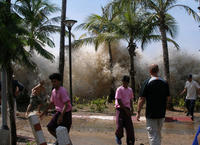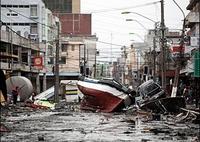-
Disaster scams on the rise
In the immediate aftermath of natural disasters, fraudsters have increasingly rushed in to take advantage of the outpouring of charitable donations; speaking on a panel at an international symposium on organized fraud in Australia, the Department of Justice’s deputy chief for strategy and policy in the Fraud Section of the Criminal Division, said scammers had websites for fake charities in place before predicted disasters had even hit
-
-
Connecticut town considers charging centers for power outages
Following Hurricane Irene which left thousands without power up and down the East Coast, a town in Connecticut is considering building several charging stations for residents to power up their hand held electronics during a natural disaster or prolonged power outage
-
-
Georgia shows app that prepares state residents, guides them to safety
New Ready Georgia mobile app uses geo-location to deliver alerts, create emergency plans, and show shelter locations; from up-to-the-minute weather and hazard alerts based on a user’
‘s location, to customizable emergency preparedness checklists, the app combines a set of features not previously available in one mobile application -
-
NIST offers comprehensive risk assessment guidance for federal information systems
NIST has released two new publications dealing with risk assessment; one is the authoritative source of comprehensive risk assessment guidance for federal information systems, the other, an update to a March 2011 publication, focuses exclusively on risk assessments
-
-
Saving victims trapped under concrete
New tool allow first responders to reach those trapped beneath concrete more quickly; the tool generates a high-energy jolt to create a contained hole in the concrete; a series of these holes allows the creation of an area large enough to deliver vital supplies such as food, water, and medicine to victims before first responders are able to get victims to safety.
-
-
Better understanding of how tsunamis work

One of the obstacles to understanding how tsunamis work is the notion that it is the first wave that is the worst; researchers show that this is not the case, and that the second, third, or even fourth wave are often the most destructive
-
-
Proton-based transistor could let machines communicate with humans
Devices humans use, from light bulbs to iPods, send information using electrons; human bodies and all other living things, on the other hand, send signals and perform work using ions or protons; researchers build a novel transistor that uses protons, creating a key piece for devices that can communicate directly with living things
-
-
Tsunami-predicting software to help protect coastal communities

New software has been developed to help protect vulnerable coastal communities from the destruction of a tsunami; the mathematical model has created significant interest in the wake of the 2011 earthquake and tsunami in Japan six months ago
-
-
Japan nuke accident halves nuclear power growth
The nuclear meltdown at the Fukushima Daiichi plant appears to have caused nations around the world to reconsider nuclear projects; following the accident, demand for future nuclear projects has been halved
-
-
Earth's largest environmental catastrophe: 250 million year anniversary
The eruption of giant masses of magma in Siberia 250 million years ago led to the Permo-Triassic mass extinction when more than 90 percent of all species became extinct
-
-
More than $2.1 billion in DHS preparedness grants announced
DHS announced the final allocation for twelve preparedness grant programs totaling more than $2.1 billion in federal grants; DHS grants were reduced by $780 million for the FY 2010 enacted level, nearly a quarter of FY 2010 DHS grant funding
-
-
Building codes may underestimate multiple hazard risks
Current building codes consider natural hazards individually — if earthquakes rank as the top threat in a particular area, local codes require buildings to withstand a specified seismic load; if hurricanes or tornadoes are the chief hazard, homes and buildings must be designed to resist loads up to an established maximum wind speed; engineers say that building codes should address multiple hazard scenarios
-
-
Texas drought forces military to change training

A particularly severe drought in Texas has forced the military to change the way it trains its soldiers due to the risk of starting fires; law enforcement agencies would benefit from taking note of additional safety measures put into place
-
-
Natural disasters stretch NGO relief teams to the limit
The recent spate of natural disaster has stretched the nation’s third largest NGO disaster relief program to the limit; in the last several months, the Southern Baptist Convention (SBC) has sent more than 3,300 volunteers to five natural disasters across the United States
-
-
Severe drought in Georgia, 150 counties declared disaster areas
A severe drought and excessive heat has forced the U.S. Department of Agriculture to declare 150 counties in Georgia as primary natural disaster areas; the drought began on 15 April and has caused farmers to lose more than 30 percent of their pasture, grain crops, cotton, peanuts, tobacco, and forage crops
-
More headlines
The long view
The Surprising Reasons Floods and Other Disasters Are Deadlier at Night
It’s not just that it’s dark and people are asleep. Urban sprawl, confirmation bias, and other factors can play a role.
Why Flash Flood Warnings Will Continue to Go Unheeded
Experts say local education and community support are key to conveying risk.
